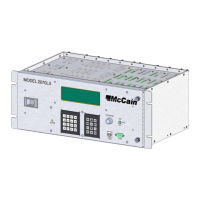2070LX Controller – User Manual 53
Version 1.0
In order to preserve the isolation between the AC and DC signals, a transformer, a diode bridge and an
electrolytic capacitor are used to generate 24VDC and feed the circuitry. Also, two opto-isolators
MOC8102 are used to isolate the outputs from the AC side to the logic side.
The AC+ line is separated through two resistor networks in order to attenuate it and also to generate a
difference on AC voltage levels, and then the AC signal is feed to the inputs of the voltage monitor device
as follow:
Input 1 the resistor network connected to this input is around 510KOhms and it is connected to a
6V zener diode.
Input 2 the resistor network connected to this input is around 998KOhms and it is connected to a
voltage divider in parallel to a 6V zener diode.
The voltage level at one zener feeds a voltage divider including a potentiometer; this voltage divider is
very sensitive and sets the trigger level for the comparator at input 2. It is used for factory adjustment to
start operation when the AC line reaches the recovery voltage level, for this model 85VAC.
The outputs of the M33161P (OUT1 and OUT2) are routed to two opto-isolators controlling them at the
cathode side, so that they are activated according to the zero crossing points of each AC input network.
These two isolated signals become the CLOCK and CLEAR signals for the D-Type Flip-Flop whose
output is a pulse synchronized to the AC input line called AC monitor.
AC monitor
This signal is generated at the D-type flip-flop which is receiving the alternating signals coming from the
opto-isolators at the CLOCK and CLEAR inputs, one input sets the output and the other input clears the
output; the generated pulse is synchronized to the AC line because of the zero-crossing detection circuit.
The pulse is monitored by the microcontroller becoming into an interruption, based on the presence or
absence of this interruption, the microcontroller generates the control signals LINESYNC, ACFAIL,
ACFAIL/PWR DOWN and PWR UP/SYS RESET.
The zero-crossing circuit is adjusted via the potentiometer to obtain this signal while the AC line is above
the 85VAC, if the AC line goes below 85VAC then any valid pulse is generated and it is interpreted by the
microprocessor as a power failure.
Microcontroller
The Power Supply control is handled by an 8-bit high performance Freescale microcontroller
MC9S08QG8 running at 15.36MHz.
The microcontroller has the next tasks:
Monitors the AC monitor interruption.
Generate the control signals: ACFAIL/POWERDOWN, POWERUP/SYSTEMRESET and
LINESYNC.
Monitors the voltage levels through three ADC; +5VDC, +12VDC and -12VDC.
Activates the LED indicators for three voltages; +5VDC, +12VDC and -12VDC.

